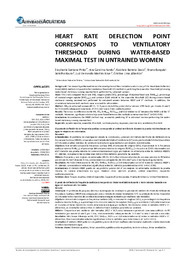Please use this identifier to cite or link to this item:
https://hdl.handle.net/11000/32486Full metadata record
| DC Field | Value | Language |
|---|---|---|
| dc.contributor.author | Santana Pinto, Stephanie | - |
| dc.contributor.author | Kanitz, Ana Carolina | - |
| dc.contributor.author | Barreto David, Gabriela | - |
| dc.contributor.author | Ezequiel Botelho Xavier, Bruno | - |
| dc.contributor.author | Kruel, Luiz Fernando Martins | - |
| dc.contributor.author | Lima Alberton, Cristine | - |
| dc.contributor.other | Departamentos de la UMH::Ciencias del Deporte | es_ES |
| dc.date.accessioned | 2024-07-17T07:15:35Z | - |
| dc.date.available | 2024-07-17T07:15:35Z | - |
| dc.date.created | 2024-04-30 | - |
| dc.identifier.citation | RIAA, Vol. 8 Núm. 14 (2024) : Monográfico 2024 | es_ES |
| dc.identifier.issn | 2530-805X | - |
| dc.identifier.uri | https://hdl.handle.net/11000/32486 | - |
| dc.description.abstract | Background: The research problem addresses the investigation of the correlation and accuracy of the Heart Rate Deflection Point (HRDP) method compared to the Ventilatory Threshold (VT) method in predicting the Anaerobic Threshold (AT) during water-based stationary running maximal tests performed by untrained women. Goals: This study compared heart rate (HR), oxygen uptake (VO2), percentage of maximal heart rate (%HRmax), percentage of maximal oxygen uptake (%VO2max), and cadence (CAD) related to the anaerobic threshold (AT) during a water-based stationary running maximal test performed by untrained women between HRDP and VT methods. In addition, the correlations between both methods were assessed for all variables. Method: Fifty-six untrained women (40.2 ± 16.3 years) started the protocol at a cadence of 85 beats per minute (b.min-1) for 3 min with subsequent increments of 15 b.min-1 every 2 min until exhaustion. Results: There was no difference in the HR, VO2, %HRmax, %VO2max, and CAD related to AT between the HRDP and the VT methods. Moreover, significant relationships were found between the methods to determine the AT (r=0.61-0.95). Conclusions: In conclusion, the HRDP method may accurately predicting AT in untrained women performing the water- based stationary running maximal test. | es_ES |
| dc.description.abstract | Antecedentes: El problema de investigación aborda la correlación y precisión del método del Punto de Deflexión de la Frecuencia Cardíaca (HRDP) comparado con el método del Umbral Ventilatorio (VT) en la predicción del Umbral Anaeróbico (AT) durante pruebas máximas de carrera estacionaria en agua realizadas por mujeres no entrenadas. Objetivos: Este estudio comparó la frecuencia cardíaca (HR), el consumo de oxígeno (V�O2), el porcentaje de la frecuencia cardíaca máxima (%HRmax), el porcentaje del consumo máximo de oxígeno (%VO2max) y la cadencia (CAD) relacionados con el AT durante una prueba máxima de carrera estacionaria en agua por mujeres no entrenadas entre los métodos HRDP y VT. Además, se evaluaron las correlaciones entre ambos métodos para todas las variables. Método: Cincuenta y seis mujeres no entrenadas (40,2 ± 16,3 años) iniciaron el protocolo con una cadencia de 85 latidos por minuto (b.min-1) durante 3 min, con incrementos subsiguientes de 15 b.min-1 cada 2 min hasta el agotamiento. Resultados: No hubo diferencia en la HR, VO2, %HRmax, %VO2max y CAD relacionados con el AT entre los métodos HRDP y VT. Además, se encontraron relaciones significativas entre los métodos para determinar el AT (r=0.61-0.95). Conclusiones: El método HRDP puede ser un predictor preciso del AT en mujeres no entrenadas realizando la prueba máxima de carrera estacionaria en agua. Palabras clave: ejercicio acuático, umbral anaeróbico, respuestas cardiorrespiratorias. | es_ES |
| dc.format | application/pdf | es_ES |
| dc.format.extent | 5 | es_ES |
| dc.language.iso | eng | es_ES |
| dc.publisher | Universidad Miguel Hernández de Elche | es_ES |
| dc.rights | info:eu-repo/semantics/openAccess | es_ES |
| dc.rights.uri | http://creativecommons.org/licenses/by-nc-nd/4.0/ | * |
| dc.subject | Aquatic exercise | es_ES |
| dc.subject | anaerobic threshold | es_ES |
| dc.subject | cardiorespiratory responses | es_ES |
| dc.subject | exercise test | es_ES |
| dc.subject | ventilatory threshold | es_ES |
| dc.subject | Terapia Acuática | es_ES |
| dc.subject | Umbral Anaerobio | es_ES |
| dc.subject | Capacidad Cardiovascular | es_ES |
| dc.subject | Prueba de Esfuerzo | es_ES |
| dc.subject | Umbral Ventilatorio | es_ES |
| dc.subject.other | CDU::796 - Deportes | es_ES |
| dc.title | Heart rate deflection point corresponds to ventilatory threshold during water-based maximal test in untrained women | es_ES |
| dc.title.alternative | El punto de deflexión de la frecuencia cardíaca corresponde al umbral ventilatorio durante la prueba máxima basada en agua en mujeres no entrenadas. | es_ES |
| dc.title.alternative | O ponto de deflexão da frequência cardíaca corresponde ao limiar ventilatório durante o teste máximo baseado em água em mulheres não treinadas. | es_ES |
| dc.type | info:eu-repo/semantics/article | es_ES |
| dc.relation.publisherversion | https://doi.org/10.21134/riaa.v2i4.1503 | es_ES |

View/Open:
1. HERAT RATE REFLECTION (1).pdf
434,17 kB
Adobe PDF
Share:
.png)
